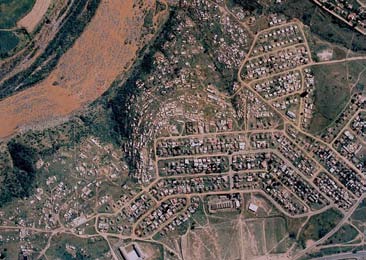Casestudy 07Soutn Africa
Debating Integrated Development Plans across a local authority
- description
- further information

© Christine Platt
In 2000, a new form of local government was instituted in South Africa, changing the role of local authorities from one with limited service provision and regulatory powers to a broad developmental function. A key part of this was the planning of development at local level through IDPs, which are essentially oriented to identifying local development needs and potential and relating these to the management, budgeting and planning functions of local authorities. Every municipality in South Africa is required to produce five-year strategic plans that are reviewed annually in consultation with communities and stakeholders. The plans seek to promote integration by balancing social, economic and ecological pillars of sustainability and coordinating actions across sectors and spheres of government. They must contain a vision for the development of the municipal area, and development objectives, strategies, projects and programmes.
The preparation process of the IDP is not seen as a one-off planning exercise, but is rather the start of a new process of strategic local government. IDPs bridge and integrate: equal spheres of government (vertical coordination); sectors (horizontal coordination); urban and rural, non-tribal and tribal areas; and overcome historic racial divisions and inequalities. Another key challenge is about building social inclusion in a diverse cultural context with a developmental objective and balancing basic economic priorities between local needs and strategic opportunities. The issue of social inclusion is of particular importance given the deep social rifts and functional dislocation inherited from the apartheid past.
eNdondakusuka, Kwa-Zulu Natal, is a new municipality formed after the local government demarcation process in 2000. The IDP process commenced in December 2001. It was important that the newly and democratically elected representatives were sufficiently empowered to facilitate community awareness at ward level. In addition, it was considered necessary to ensure non-political engagement, so advertisements were placed in the local press calling for interested parties to register for representation on the statutory Representative Forum. A total of 109 organizations representing social groups, civic associations and economic interest groups, from organized labour and residents associations to sport and drama groups, registered. Key stakeholders who had not necessarily responded were further identified and invited to attend all workshops and meetings.
The two Representative Forum meetings and seven sectoral workshops elicited very positive interest. Approximately 600 people attended, with representation from all sectors of the local community. Participants were encouraged to speak out and express their views on the topics addressed. The final outcome was a list of priority issues to be addressed by the IDP. Rather than a list of compiled wishes, this was a prioritized list of real concerns, which had been discussed, debated and agreed on (or at least accepted) by all community representatives during the workshops. The workshops were facilitated by the local authority’s planner together with a professional Zulu speaking facilitator, where necessary. It was imperative that all participants felt free to use whichever language they felt most comfortable with. Another important point was that nothing had been written prior to the workshops and there were no prior positions for the local authority or the planner to defend.
The draft proposals were considered in another workshop with the elected councillors and officials. The final IDP document was then advertised for public comment before being presented at a final Representative Forum meeting. There was facilitation by a consultant planner throughout the IDP preparation process to ensure that issues raised were translated into strategies that were achievable given the limited resources of the eNdondakusuka municipality. Any issue raised was tested to see if the problem was shared among the broader community. There were also instances where the community was happy to accept that there were specific concerns coming from a particular group that had merit and needed to be recorded as a priority of the community in its broadest sense.
The fact that the negotiation and mediation of the plan was done at the local authority scale with all participants hearing the points raised by each other was critical to the coherence, legitimacy and feasibility of the IDP. Preparation of smaller scale local area plans by, for example, ward level groups, would have made the task of marrying competing demands at a later stage difficult, if not impossible. Moreover, preparing plans through mutual listening enabled people to hear one another’s concerns and to understand better the needs and interests within the broader community. Officials learned by hearing how the community as whole responded regarding competing needs. Many participants expressed how they had learnt from, and about, one another in the process: ‘protest has been changed into development’.
The case of the eNdondakusuka IDP is notable for the success achieved in building consensus among diverse groups in a very short space of time and with very limited use of professional staff resources. The participatory processes have been successfully sustained through IDP reviews. The system of Representative Forum meetings coupled with community-based sectoral workshops has been continued over the past four years and, critically, the understanding shown by the community at the start of the IDP process about the limitations and reality of development in a resource-poor municipality has been sustained. The 2002 IDP has now reached the end of its life, following the recent local authority elections, and at the last Representative Forum meeting, community representatives expressed their satisfaction at the degree to which the priority issues agreed with the community in 2002 had been addressed by the municipality.Go back to case studies listing
A Guide to Integrated Development Planning for Local Government in South Africa, http://www.etu.org.za/toolbox/docs/localgov/webidp.html
OPDM (2003) Participatory Planning for Sustainable Communities: International Experience in Mediation, Negotiation and Engagement in Making Plans, Office of the British Deputy Prime Minister, London
President
PO Box 12381
BENORYN
1504
